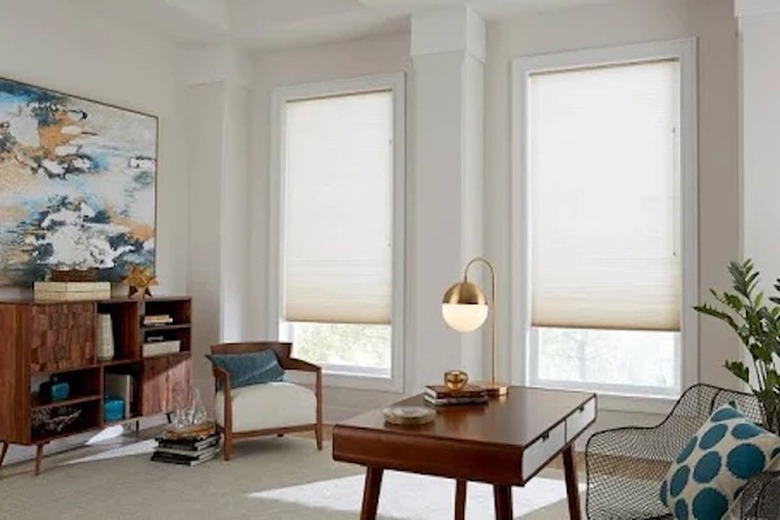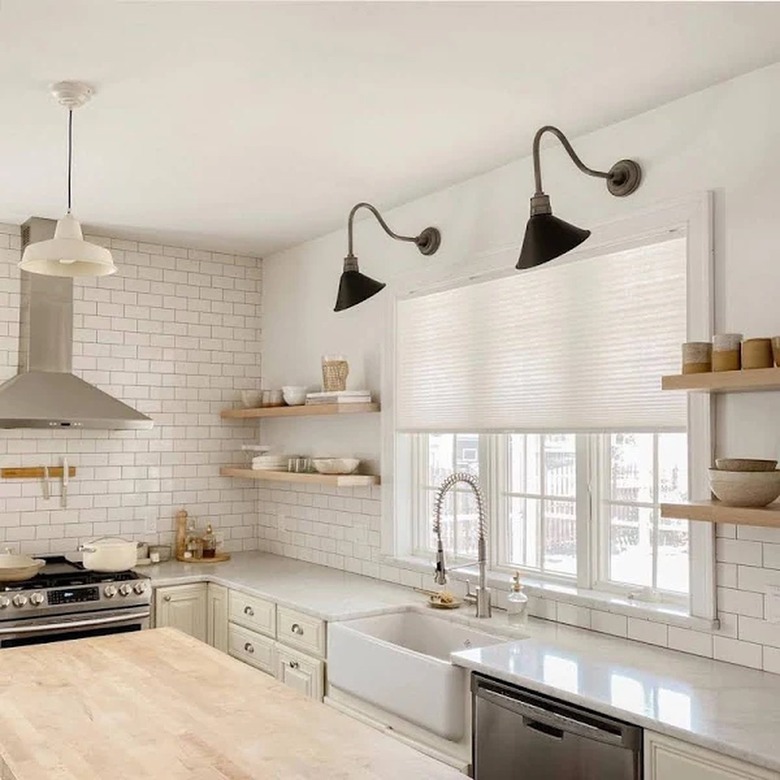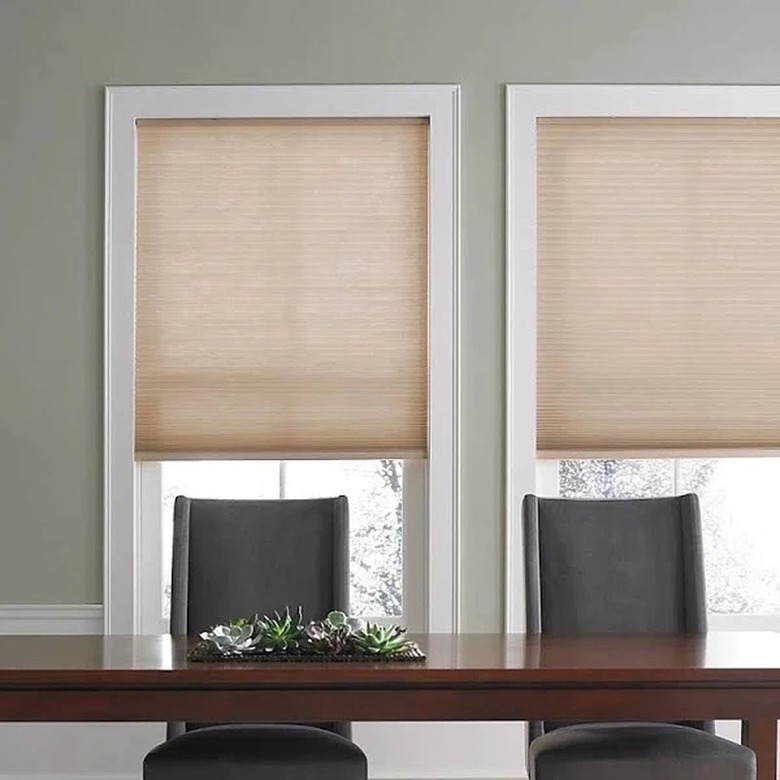Cellular Shades Can Lower Your Energy Bills — But Are They Right For Your Windows?
We may receive a commission on purchases made from links.
Looking for a window treatment that will help you lower your energy bills? Cellular shades are a popular window treatment and an energy-efficient alternative to pleated window shades, as they help keep out heat on hot, sunny days and keep out cold air on blustery, cold days. They function in much the same way as pleated shades and have nearly as many options in terms of how they open, how they look, and how much light blocking they can do. Cellular shades are most useful over windows that let in too much afternoon light in summer or drafty windows that let in cold air in winter. But for as many pros as they have, there are a few cons: Namely, they're not the best choice for damp locations, such as next to a shower in a small bathroom.
Thinking about buying some cellular shades for your windows? Here's everything you need to know before you shop.
Tip
Cellular shades have honeycomb-style air pockets between the front and back. The cells are air pockets that can provide energy savings.
Cellular Shades: The Basics
Cellular Shades: The Basics
As the name implies, cellular shades have "cells," or air pockets, between the front and back, unlike regular pleated shades. If viewed from the side, cellular shades look a bit like the cells of a honeycomb, with gaps between the front and back of the shade. By comparison, regular pleated shades look more like fabric folded into accordion-style, thin strips not unlike the paper fans children make in elementary school.
Cellular shades typically come as single-cell or double-cell shades. The double-celled type costs more due to the complexity of the design and its added ability to block temperature extremes between the window and the ambient room temperature. Though less common, triple-cell honeycomb shades are offered by some manufacturers and cost more than those with fewer cells.
As with pleated shades, cellular shades are available to fit just about any square or rectangular window. Besides the options for the full-shade size, the pleats in cellular shades are available in various sizes, with the largest pleats best for large windows. The pleat difference from one size to the next isn't overly noticeable, however, as they usually go up by 1/16-inch increments from 3/8 inch to 3/4 inch.
Cellular Shade Control Options
Cellular Shade Control Options
In addition to different colors and sizes, cellular shades can also vary in the ways the shades open and close. One common, cord-controlled option is called a top-down, bottom-up shade, which allows you to choose whether to open the shade from the bottom, the top, or both ends at once. The controls are separate cords that adjust the top and bottom edges of the shade independently. These can take a little while to get used to, but they're ideal for letting in light exactly where you want it or for adding privacy just where you need it.
Some manufacturers also offer a cordless version of the top-down, bottom-up shade, which works by lifting the bottom shade edge or gently pushing the top edge downward to let more light indoors. Other types of cordless shades often have a tab on the bottom for lifting and lowering the shade, and the shade stays where you leave it in any position. Yet another cordless option features a wandlike device with up and down buttons for motorized control. In some cases, these shades can also be operated via a remote control.
Cordless cellular shades are a great choice in any home with young children or pets, as there's no chance of getting tangled in the cord or accidentally tangling or damaging the cord. The motorized, remote-operated varieties are excellent for windows that are too high to reach with ease.
Choose the Ideal Opacity
Choose the Ideal Opacity
As with curtains and pleated shades, cellular shades come in a variety of opacities so you're able to tailor the shades to suit the space. Sheer shades are translucent, letting in a lot of light and offering minimal privacy. Semisheer shades are just a little harder to see through, so they provide good light control for privacy but don't make it completely dark. Semiopaque shades let in some natural light but offer quite a bit of privacy, while totally opaque or blackout shades have room darkening capabilities even on a sunny day.
Semisheer and semiopaque shades are good options for dining rooms, hallways, or even living rooms, as they'll allow in some light. If you like to wake up when the sun rises, they're ideal for the bedroom too. For those working odd hours or who have a baby in sleep training, semiopaque or blackout shades are the best option
Where to Use Them (or Not)
Where to Use Them (or Not)
Cellular shades can be used virtually anywhere you'd use other shades, with a few careful considerations. Since these are made of fabric rather than a nonporous material, they're not ideal near the stove, in musty areas, or in rooms where people smoke cigarettes or cigars. Cellular shades absorb odors and moisture, so they're not good to use in overly humid environments, such as near showers or tubs.
It's best to use cellular shades in rooms with windows that feel drafty or where too much light comes in during certain parts of the day. If cost is an issue, choose a cellular shade for the sun-facing window and matching pleated shades for the other windows in the room. If your retailer offers UV-blocking cellular shades, choose that option for the window that lets in too much light on a summer afternoon. For bedrooms, nurseries, and media rooms, choose opaque or blackout cellular shades to block out the most sunlight possible.
Cleaning and Maintaining Cellular Shades
Cleaning and Maintaining Cellular Shades
As with just about any window covering, cellular shades eventually collect dust. One downside to the open cell structure is that dust, pet hair, or even insects can get inside the cells. Clean the outside surface with a feather duster or a microfiber cloth or mitt whenever you schedule your household dusting. A vacuum cleaner with an upholstery brush attachment helps loosen dust or pet hair clinging to the shades but use extra care with a vacuum cleaner, as too much suction could damage delicate shades.
To clean inside the cells, a can of compressed air, like the type used for cleaning between the keys on a computer keyboard, comes in handy. Be prepared for the debris to shoot out the other end of the cell if using this method. Use old sheets of newspaper or cardboard on the ground to catch the grime. If you don't have compressed air, a hair dryer with a low- or no-heat setting does the trick, as does a vacuum cleaner with the option to blow air out of the hose.
Removing stains is a bit trickier, as any moisture-based cleaning methods could harm the materials or adhesives used to keep the shades together. Check the cleaning instructions for your particular shades, or start with the least harsh cleaning methods possible, such as a few drops of water on a microfiber cloth or a melamine cleaning sponge. Test-clean an inconspicuous area first for best results. Repair out-of-whack shades by pulling them all the way down to close them, which returns them to level and allows normal operation once again.


